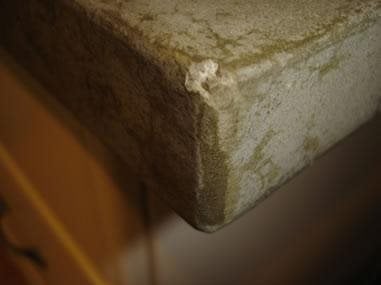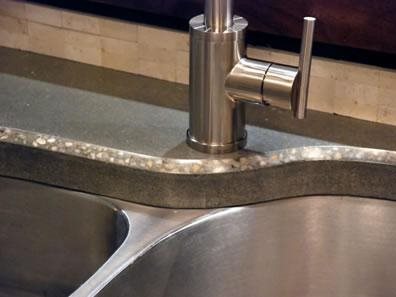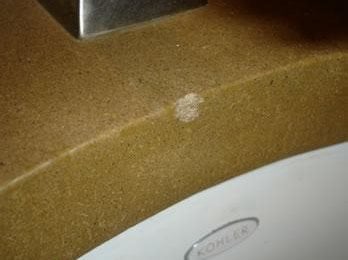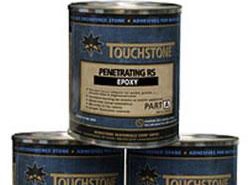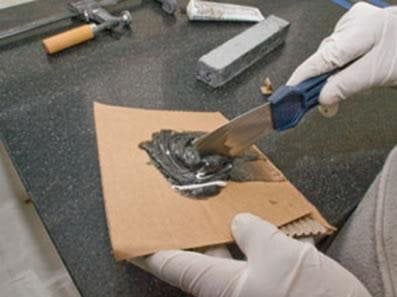- Countertop Supplies Home
- Concrete Countertop Molds
- Concrete Countertop Mix
- Pigments & Custom Options: Color additives, special effects & decorative add-ins
- Countertop Reinforcement
- Casting Equipment: Tables, mixers, vibrators & curing covers
- Countertop Finishing & Installation
- How to Polish Concrete Countertops
- Sealers for Concrete Countertops
- Delivery and Installation
- Related Reading
- Problems with Concrete Countertops
- Countertop Product Reviews
- Concrete Countertop Basics: Pricing, colors, edge details, and more
Patching Concrete Countertops to Repair Chips
Question:How do I fix chips in the edges of concrete countertops? My clients dropped a pan on the edge of their countertop and knocked out a chip of concrete.
Need help with patching?
Find concrete countertop contractors near me
Answer:Chips can happen when a sharp impact occurs near the corner or edge of a concrete countertop. These areas are vulnerable because there is little material available to resist the full impact of a pot, pan or other heavy object.
Edges that are well rounded or beveled help deflect the blow, changing the type of impact force from a shearing force to a compression force. It's easy to knock a chip off of the edge or corner of a cube, for example. However, a blow to a solid sphere results in a straight-on impact or a glancing blow, with no corners to chip off.
Often concrete that is an all-sand based mix or a minimally processed cement-finished mix tends to be more chip prone than an exposed coarse-aggregate mix. This is because larger aggregate particles are well interlocked and resist chipping forces better than concrete mixes with sand as the aggregate. Plus exposed gravel-sized particles tend to have higher tensile strengths than the cement binder surrounding the particles. Sand itself is stronger than the cement paste, but the particle sizes are small, so the fracture zone tends to follow the cement paste rather than passing through the aggregate.
Chips can be repaired in a variety of ways, but the process is similar. If the chip that came off the concrete is available and still intact, you can glue it back on. If the chip fragment is unavailable, the damaged area can be filled with new material. Either way, the adhesive or filler needs to be color matched to blend in. In most cases, the chip repair doesn't have to be perfect; it simply needs to visually blend in with the rest of the countertop.
Usually epoxy used for laminating granite and stone is the adhesive or filler of choice. It is easy to work with, cures fast and doesn't need to be sealed. The epoxy can be tinted with pigments made for the epoxy, dry concrete pigments or dry powdered concrete that matches the color of the countertop. Keep in mind that the epoxy will appear darker because it wets out the concrete surface (just like water darkens dry concrete). You might need to adjust the shade and intensity of the tinted epoxy with titanium-white pigment (or other compatible white or light-colored material) to visually match the concrete.
Because epoxy is a two-part material, always measure out the correct portions of part A and part B, but tint only one of the parts before mixing. If you mix the parts together first you will be working against the clock, because some epoxies can set up fast. By tinting only one of the parts, you have all the time you need to get the color just right. When you're pleased with the color, then mix in the other part to create the tinted epoxy. Usually one of the parts is more clear and colorless than the other part. Be sure to tint the part that is less clear and more opaque, so when you finally blend the non-tinted part with the tinted part the color won't change.
If you are using epoxy, avoid using excess epoxy to restore the chip. It will be hard to sand down the excess if your concrete is protected with a sealer, unless you plan on resealing the area scratched by the sanding process. Usually it's possible to scrape and slice off excess epoxy while it's still in a soft, pliable state. Once it hardens, only sanding will remove it.
Cement grout can be used as a repair material instead of epoxy where a more consistent appearance is desired and for outdoor applications (most epoxies yellow in sunlight). Used plain, the grout patch will appear uniform and solid in appearance. By mixing in sand that is similar to what was used in the concrete, it's possible to better match the visual texture of the cement grout repair. The excess can be carefully honed with diamond hand pads.
I recommend using a calcium sulfo-aluminate cement grout instead of portland cement grout because it has a much faster curing rate. Because this is a cement-based repair, it will need to be sealed to protect the repaired area from stains.
Return to Fixing Concrete Countertops
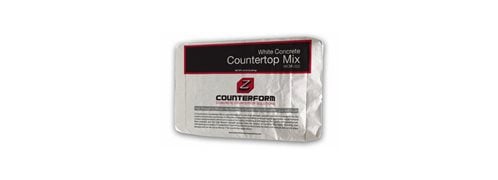 White Countertop Mix
Pre-blended, all in one, high strength castable concrete mix.
White Countertop Mix
Pre-blended, all in one, high strength castable concrete mix.
 SS EZ Top Resurfacing Kit
Apply over laminate, solid surface, and tile countertop surfaces.
SS EZ Top Resurfacing Kit
Apply over laminate, solid surface, and tile countertop surfaces.
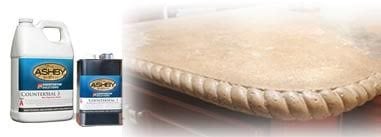 Topcoat Sealer
Produces a scratch and stain resistant top coating.
Topcoat Sealer
Produces a scratch and stain resistant top coating.
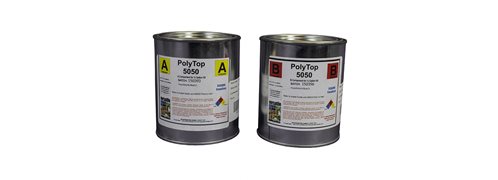 PolyTop Sealer
Designed for speed and heat resistance.
PolyTop Sealer
Designed for speed and heat resistance.
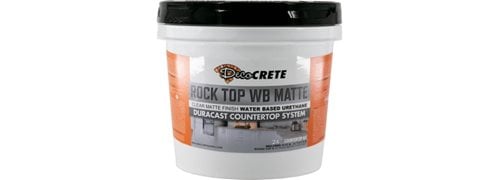 Rock Top Sealer
Clear matte finish, water-based urethane
Rock Top Sealer
Clear matte finish, water-based urethane
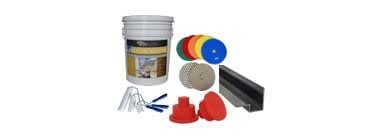 Countertop Products
All the supplies needed for great countertops.
Countertop Products
All the supplies needed for great countertops.
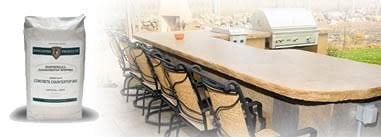 Imperial Countertop Mix
Engineered to be lightweight and strong. Minimal shrinkage.
Imperial Countertop Mix
Engineered to be lightweight and strong. Minimal shrinkage.
 Professional Grade Counter Mix
Easy finish, minimal shrinkage & exceptional strength
Professional Grade Counter Mix
Easy finish, minimal shrinkage & exceptional strength
